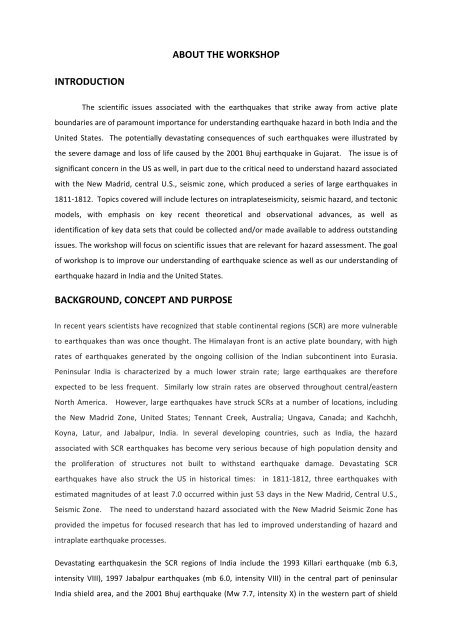indo–us workshop on “intraplate seismicity†- The CERI Blog
indo–us workshop on “intraplate seismicity†- The CERI Blog
indo–us workshop on “intraplate seismicity†- The CERI Blog
Create successful ePaper yourself
Turn your PDF publications into a flip-book with our unique Google optimized e-Paper software.
INTRODUCTION<br />
ABOUT THE WORKSHOP<br />
<strong>The</strong> scientific issues associated with the earthquakes that strike away from active plate<br />
boundaries are of paramount importance for understanding earthquake hazard in both India and the<br />
United States. <strong>The</strong> potentially devastating c<strong>on</strong>sequences of such earthquakes were illustrated by<br />
the severe damage and loss of life caused by the 2001 Bhuj earthquake in Gujarat. <strong>The</strong> issue is of<br />
significant c<strong>on</strong>cern in the US as well, in part due to the critical need to understand hazard associated<br />
with the New Madrid, central U.S., seismic z<strong>on</strong>e, which produced a series of large earthquakes in<br />
1811-‐1812. Topics covered will include lectures <strong>on</strong> intraplateseismicity, seismic hazard, and tect<strong>on</strong>ic<br />
models, with emphasis <strong>on</strong> key recent theoretical and observati<strong>on</strong>al advances, as well as<br />
identificati<strong>on</strong> of key data sets that could be collected and/or made available to address outstanding<br />
issues. <strong>The</strong> <str<strong>on</strong>g>workshop</str<strong>on</strong>g> will focus <strong>on</strong> scientific issues that are relevant for hazard assessment. <strong>The</strong> goal<br />
of <str<strong>on</strong>g>workshop</str<strong>on</strong>g> is to improve our understanding of earthquake science as well as our understanding of<br />
earthquake hazard in India and the United States.<br />
BACKGROUND, CONCEPT AND PURPOSE<br />
In recent years scientists have recognized that stable c<strong>on</strong>tinental regi<strong>on</strong>s (SCR) are more vulnerable<br />
to earthquakes than was <strong>on</strong>ce thought. <strong>The</strong> Himalayan fr<strong>on</strong>t is an active plate boundary, with high<br />
rates of earthquakes generated by the <strong>on</strong>going collisi<strong>on</strong> of the Indian subc<strong>on</strong>tinent into Eurasia.<br />
Peninsular India is characterized by a much lower strain rate; large earthquakes are therefore<br />
expected to be less frequent. Similarly low strain rates are observed throughout central/eastern<br />
North America. However, large earthquakes have struck SCRs at a number of locati<strong>on</strong>s, including<br />
the New Madrid Z<strong>on</strong>e, United States; Tennant Creek, Australia; Ungava, Canada; and Kachchh,<br />
Koyna, Latur, and Jabalpur, India. In several developing countries, such as India, the hazard<br />
associated with SCR earthquakes has become very serious because of high populati<strong>on</strong> density and<br />
the proliferati<strong>on</strong> of structures not built to withstand earthquake damage. Devastating SCR<br />
earthquakes have also struck the US in historical times: in 1811-‐1812, three earthquakes with<br />
estimated magnitudes of at least 7.0 occurred within just 53 days in the New Madrid, Central U.S.,<br />
Seismic Z<strong>on</strong>e. <strong>The</strong> need to understand hazard associated with the New Madrid Seismic Z<strong>on</strong>e has<br />
provided the impetus for focused research that has led to improved understanding of hazard and<br />
intraplate earthquake processes.<br />
Devastating earthquakesin the SCR regi<strong>on</strong>s of India include the 1993 Killari earthquake (mb 6.3,<br />
intensity VIII), 1997 Jabalpur earthquakes (mb 6.0, intensity VIII) in the central part of peninsular<br />
India shield area, and the 2001 Bhuj earthquake (Mw 7.7, intensity X) in the western part of shield


